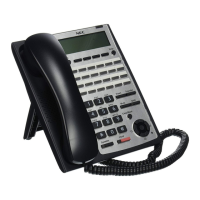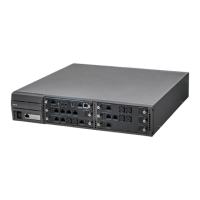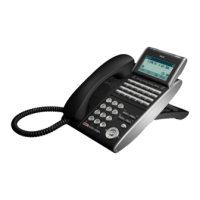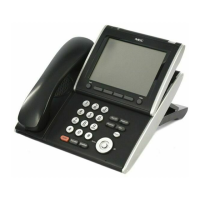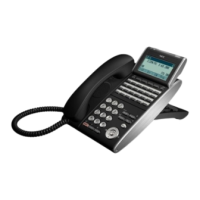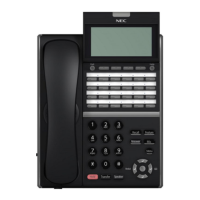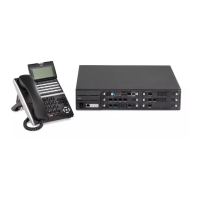











Do you have a question about the NEC SL2100 and is the answer not in the manual?
Details the process of connecting the handset and LAN cable to the telephone base.
Explains how to adjust the tilt legs for optimal viewing angle and height.
Identifies and describes the various keys and physical parts of the DT920 terminal.
Provides detailed technical information and specifications for the DT920 terminal.
Illustrates the screen layout and explains the functionality of various keys on the terminal.
Details the information displayed and programmed for Function Keys.
Describes the Liquid Crystal Display (LCD) capabilities and information shown.
Explains how to access and use the Menu Key for terminal settings and features.
Covers the procedures for initiating various types of calls, including outside and intercom calls.
Provides methods for quickly placing calls, such as directory dialing and last number redial.
Explains how to use the directory to find and dial contact numbers.
Details how to redial the last dialed number from the call history.
Explains how to initiate a callback using received call information (Caller-ID).
Describes how to use abbreviated or speed dialing for making outside calls.
Explains how to place calls using One-Touch or DSS keys.
Covers procedures when calls cannot be completed, including Camp On and Callback.
Covers setting Camp On or Callback features when calls cannot be completed.
Details how to cancel a previously set Camp On or Callback.
Explains the process of setting up and using repeat dialing for outside calls.
Describes how to respond to a message waiting indicator and access voicemail.
Details how to cancel the message waiting indicator.
Covers procedures for answering incoming calls.
Explains how to answer an incoming outside call.
Describes how to answer an incoming intercom call.
Explains how to answer a call directed to another extension.
Details procedures for holding, retrieving, and transferring calls.
Details the procedures for placing calls on hold and retrieving them.
Explains how to place a call on exclusive hold, preventing others from retrieving it.
Describes how to retrieve an outside call that has been placed on hold.
Details how to transfer an active call to another extension.
Covers convenient features for enhanced usability.
Explains how to enable or disable the Do Not Disturb (DND) feature.
Covers the procedure for setting up and managing conference calls.
Covers setting up call forwarding to another extension or following the user.
Explains how to navigate the terminal's menu structure using the Menu Soft Key.
Describes how to use the 'Dir' Soft Key to access the directory dialing feature.
Explains how to access voicemail messages using the 'VM' Soft Key.
Details how to access the Caller-ID List using the 'CL' Soft Key.
Outlines soft key functions available when the handset is off-hook or speaker is used.
Describes soft key functions available during an intercom call.
Explains soft key functions available after an intercom call is established.
Details soft key functions available during an outside call.
Illustrates the menu structure accessible via cursor keys in Standard Mode.
Shows the menu structure for cursor key navigation in Advanced Mode 1.
Details the soft key structure and navigation when set to Standard Mode.
Provides instructions on how to log in to the In-Mail voicemail system.
Details how to set up call forwarding to the voicemail system.
Explains how to record and manage mailbox greetings.
Details how to set and manage mailbox security codes for access.
Provides instructions on how to listen to voicemail messages left in the mailbox.
Instructions for logging into the In-Mail system as a system administrator.
Explains how to manage distribution lists for voicemail messages.
Details how to modify subscriber mailboxes, including messages, greetings, and names.
Describes how to set up alternate answering for the Automated Attendant.
Explains how to record and modify mailbox announcement messages.
Details the process of connecting the handset and LAN cable to the telephone base.
Explains how to adjust the tilt legs for optimal viewing angle and height.
Identifies and describes the various keys and physical parts of the DT920 terminal.
Provides detailed technical information and specifications for the DT920 terminal.
Illustrates the screen layout and explains the functionality of various keys on the terminal.
Details the information displayed and programmed for Function Keys.
Describes the Liquid Crystal Display (LCD) capabilities and information shown.
Explains how to access and use the Menu Key for terminal settings and features.
Covers the procedures for initiating various types of calls, including outside and intercom calls.
Provides methods for quickly placing calls, such as directory dialing and last number redial.
Explains how to use the directory to find and dial contact numbers.
Details how to redial the last dialed number from the call history.
Explains how to initiate a callback using received call information (Caller-ID).
Describes how to use abbreviated or speed dialing for making outside calls.
Explains how to place calls using One-Touch or DSS keys.
Covers procedures when calls cannot be completed, including Camp On and Callback.
Covers setting Camp On or Callback features when calls cannot be completed.
Details how to cancel a previously set Camp On or Callback.
Explains the process of setting up and using repeat dialing for outside calls.
Describes how to respond to a message waiting indicator and access voicemail.
Details how to cancel the message waiting indicator.
Covers procedures for answering incoming calls.
Explains how to answer an incoming outside call.
Describes how to answer an incoming intercom call.
Explains how to answer a call directed to another extension.
Details procedures for holding, retrieving, and transferring calls.
Details the procedures for placing calls on hold and retrieving them.
Explains how to place a call on exclusive hold, preventing others from retrieving it.
Describes how to retrieve an outside call that has been placed on hold.
Details how to transfer an active call to another extension.
Covers convenient features for enhanced usability.
Explains how to enable or disable the Do Not Disturb (DND) feature.
Covers the procedure for setting up and managing conference calls.
Covers setting up call forwarding to another extension or following the user.
Explains how to navigate the terminal's menu structure using the Menu Soft Key.
Describes how to use the 'Dir' Soft Key to access the directory dialing feature.
Explains how to access voicemail messages using the 'VM' Soft Key.
Details how to access the Caller-ID List using the 'CL' Soft Key.
Outlines soft key functions available when the handset is off-hook or speaker is used.
Describes soft key functions available during an intercom call.
Explains soft key functions available after an intercom call is established.
Details soft key functions available during an outside call.
Illustrates the menu structure accessible via cursor keys in Standard Mode.
Shows the menu structure for cursor key navigation in Advanced Mode 1.
Details the soft key structure and navigation when set to Standard Mode.
Provides instructions on how to log in to the In-Mail voicemail system.
Details how to set up call forwarding to the voicemail system.
Explains how to record and manage mailbox greetings.
Details how to set and manage mailbox security codes for access.
Provides instructions on how to listen to voicemail messages left in the mailbox.
Instructions for logging into the In-Mail system as a system administrator.
Explains how to manage distribution lists for voicemail messages.
Details how to modify subscriber mailboxes, including messages, greetings, and names.
Describes how to set up alternate answering for the Automated Attendant.
Explains how to record and modify mailbox announcement messages.
| Mounting | Desk/Wall |
|---|---|
| Handset type | Wired handset |
| Product type | IP Phone |
| Product color | Black |
| Wi-Fi | No |
| Ethernet LAN | Yes |
| Networking standards | IEEE 802.3af |
| Ethernet LAN interface type | Gigabit Ethernet |
| Number of programmable keys | 8 |
| Display resolution | 168 x 128 pixels |
| Lines quantity | - lines |
| Phonebook capacity | - entries |
| Number of VoIP accounts | - |
| Voice codecs | G.711, G.729A |
| Number of handles included | 1 pc(s) |
| Headphone outputs | 1 |
| Ethernet LAN (RJ-45) ports | 2 |


